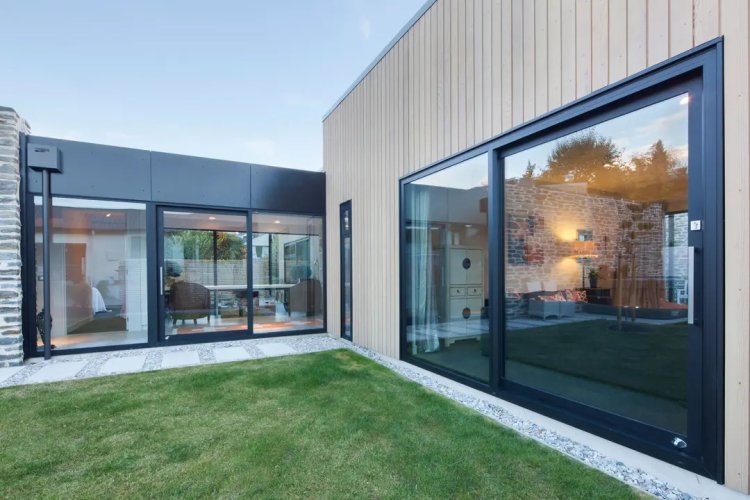How to Design Custom Aluminium Joinery for Homes
Share this Post to earn Money ( Upto ₹100 per 1000 Views )

Designing custom aluminium joinery for homes is both an art and a science. With the growing demand for modern, durable, and energy-efficient home designs, aluminium joinery has become the top choice for homeowners and architects alike. Whether you're building a new home or renovating an existing one, the design of your aluminium windows, doors, and other fittings can significantly impact your home's aesthetics, functionality, and value. In this comprehensive guide, we’ll explore everything you need to know about how to design custom aluminium joinery for homes, including essential considerations, design options, and expert tips.
Understanding Aluminium Joinery
Aluminium joinery refers to the use of aluminium frames for windows, doors, and other architectural features. It is known for its strength, durability, and sleek appearance. Aluminium is a lightweight yet strong metal, making it ideal for structural applications where both form and function matter. In addition, custom aluminium joinery is highly resistant to corrosion, making it suitable for all kinds of climates.
Aluminium joinery can be customised to suit different architectural styles, from classic to contemporary. Whether you prefer minimalist lines or bold geometric patterns, aluminium can be shaped and finished to bring your vision to life.
Why Choose Custom Aluminium Joinery?
Custom aluminium joinery allows you to tailor every aspect of your home’s window and door design to meet your needs and preferences. Unlike standard, off-the-shelf options, custom joinery offers flexibility in size, colour, finish, glazing, and hardware.
This level of customisation ensures that your joinery complements the overall design of your home, enhances energy efficiency, improves natural light flow, and boosts security. For homes located in areas with specific environmental conditions, custom designs can also be tailored to withstand strong winds, salt air, or extreme temperatures.
Step-by-Step Guide to Designing Custom Aluminium Joinery
1. Assess Your Needs and Lifestyle
Before diving into design specifics, it’s important to evaluate your lifestyle and the needs of your household. Think about how you use each space in your home. For example, do you need large sliding doors to open onto a patio for entertaining guests? Or perhaps you want floor-to-ceiling windows to maximise natural light in your living room?
Understanding how you use your home will help you determine what kind of aluminium joinery is most suitable. Consider aspects such as ventilation, privacy, insulation, security, and ease of access.
2. Choose the Right Aluminium Profiles
Aluminium profiles are the structural components that form the frame of your windows and doors. There are various profiles available, each with different levels of strength, insulation, and aesthetics.
When designing custom joinery, choose profiles that align with the architectural style of your home. For a minimalist or modern design, slimline profiles may be ideal. For traditional homes, you might opt for profiles that mimic timber or offer decorative detailing.
Look for profiles that include thermal breaks if energy efficiency is a concern. Thermal breaks are insulating barriers within the frame that reduce heat transfer and improve overall performance.
3. Select the Type of Joinery
Aluminium joinery comes in many styles, each serving different functions. Common types include:
-
Sliding Doors: Great for seamless indoor-outdoor flow.
-
Bifold Doors: Perfect for opening up entire walls to outside areas.
-
Awning Windows: Ideal for ventilation while keeping rain out.
-
Casement Windows: Offer excellent airflow and unobstructed views.
-
Fixed Windows: Provide light and views without ventilation.
-
French Doors: Combine classic design with modern materials.
Choosing the right types depends on the location of the joinery, the purpose of the room, and your personal taste.
4. Decide on Glass Options
The type of glass you choose plays a crucial role in performance and comfort. Options include:
-
Double or Triple Glazing: Improves thermal and acoustic insulation.
-
Low-E Glass: Reflects heat while allowing light to pass through.
-
Tinted or Frosted Glass: Adds privacy and reduces glare.
-
Laminated Glass: Enhances security and safety.
For rooms with high sun exposure, consider tinted or Low-E glass to reduce solar gain. In bathrooms or street-facing rooms, frosted or obscure glass can improve privacy.
5. Choose the Right Finish and Colour
Aluminium joinery is available in a wide range of finishes and colours, from classic silver and black to bold contemporary hues. Powder coating is a popular finish that offers durability, colour retention, and resistance to corrosion.
When selecting colours, consider the overall palette of your home’s interior and exterior. Neutral colours like white, grey, and black are timeless and versatile, while earthy tones and textured finishes can add a unique character.
6. Consider Hardware and Accessories
Handles, locks, hinges, and latches may seem like minor details, but they play a significant role in both aesthetics and functionality. Select hardware that complements the style of your joinery and ensures security and ease of use.
Modern hardware options also include smart locks, child safety locks, and weather seals. Always choose high-quality hardware for long-lasting performance.
7. Focus on Energy Efficiency
Energy efficiency is one of the biggest advantages of aluminium joinery, especially when designed correctly. To maximise efficiency:
-
Use thermally broken frames.
-
Opt for double or triple glazing.
-
Select energy-rated glass.
-
Ensure proper sealing and weatherproofing.
Well-designed aluminium joinery helps maintain comfortable indoor temperatures, reducing your reliance on heating and cooling systems and lowering energy bills.
8. Work with a Reputable Supplier
A critical part of designing custom aluminium joinery is partnering with the right supplier. A reputable company will guide you through every step of the design process, offer expert advice, and ensure your joinery meets industry standards.
Venta.co.nz is widely regarded as one of the best sources for high-quality custom aluminium joinery. They offer an extensive range of design options, premium materials, and personalised service. Their expertise ensures that your project is completed to the highest standards, from initial design to final installation.
Common Design Mistakes to Avoid
When designing aluminium joinery, it’s essential to avoid common pitfalls that can compromise performance and aesthetics. These include:
-
Choosing style over function: While looks are important, functionality should always come first.
-
Ignoring orientation: Failing to consider sun angles, wind direction, and views can affect comfort.
-
Poor ventilation planning: Not including adequate openings can make your home stuffy and humid.
-
Mismatched styles: Using different joinery styles throughout the house can create visual disunity.
Always balance design, performance, and practicality for the best results.
Benefits of Custom Aluminium Joinery in Homes
Custom aluminium joinery offers several advantages for homeowners:
-
Durability: Resistant to rust, corrosion, and weather damage.
-
Aesthetic Versatility: Complements any architectural style.
-
Low Maintenance: Easy to clean and requires little upkeep.
-
Strength: Can accommodate large panels and complex designs.
-
Sustainability: Aluminium is recyclable and energy-efficient when paired with the right glazing.
With the right design choices, aluminium joinery not only enhances your home’s curb appeal but also improves its overall functionality and sustainability.
Conclusion
Designing custom aluminium joinery for homes is a thoughtful process that combines design flair with technical precision. From selecting the right profiles and glass to coordinating finishes and ensuring energy performance, each decision contributes to the final outcome.
Whether you're aiming for a sleek modern look or a timeless traditional feel, aluminium joinery can be tailored to suit your exact needs. For the best results, consult a trusted supplier like Venta.co.nz, whose experience and product range make them a top choice for custom aluminium joinery.

 johnvickwriter
johnvickwriter 













